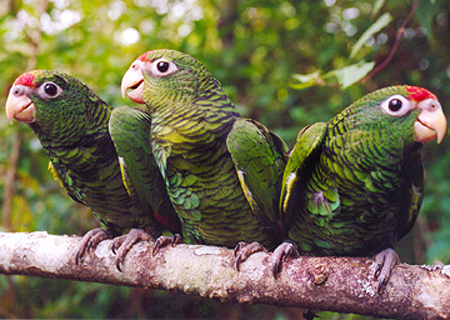 Tucuman Parrots by Luis RiveraThe rare Tucuman Parrot will benefit from protections afforded by a new reserve established by Asociación Armonía in Santa Cruz, Bolivia. The 44-acre Tucuman Parrot Reserve protects the largest Podocarpus conifer trees in the area, which are critically important as nesting sites for the parrot. The new reserve is adjacent to the Quirusillas Municipal Reserve, effectively extending the area under protection.
Tucuman Parrots by Luis RiveraThe rare Tucuman Parrot will benefit from protections afforded by a new reserve established by Asociación Armonía in Santa Cruz, Bolivia. The 44-acre Tucuman Parrot Reserve protects the largest Podocarpus conifer trees in the area, which are critically important as nesting sites for the parrot. The new reserve is adjacent to the Quirusillas Municipal Reserve, effectively extending the area under protection.
“This victory is the end result of an eight-month negotiation process and years of outreach with the local community. This action was a vital step because logging is advancing towards the forest surrounding the now protected reserve,” said German Mercado, Administration Director of Armonía.
Armonía has been working with the Quirusillas community since 2010 to raise awareness of the plight of the Tucuman Parrot and provide alternatives to logging that are consistent with sustaining and restoring local ecosystems. These activities include educational programs in local schools, developing honey production businesses, and working with women to develop handicrafts and increase their participation in community decision-making.
“Establishing this reserve is one of several strategies we are implementing to prevent the extinction of the Tucuman Parrot in this region. We are also planning to erect artificial nest boxes to increase breeding opportunities for the species and to attract tourists to this reserve. Bringing tourism dollars to the area would provide a stronger incentive for the community to continue to implement environmental protection measures,” said Bennett Hennessey, Executive Director of Armonía.
There are two main threats to the Tucuman Parrot, habitat loss and the pet trade. The cloud forest that characterizes the parrot’s natural habitat is now greatly diminished and degraded due to selective logging, which removes the largest trees parrots require for nesting, as well as cattle grazing, and agriculture. The illegal capture of the Tucuman Parrot has declined since its peak in the 1980s, but remains a major threat. Capturing these parrots for the pet trade often results in the destruction of the nesting tree, reducing potential reproduction efforts for future generations. As a result, the global population of the Tucuman has declined by 75% in the last three decades, and the species is now listed as Vulnerable to extinction by the International Union for the Conservation of Nature.
The parrot nestlings’ diet is composed almost entirely of the cones and seeds of a local conifer, called “pino de cerro” (Podocarpus parlatorei), which is becoming scarce at a global level because of logging. Currently, a local sawmill is attempting to gain logging rights to areas in the vicinity of the new reserve. If they succeed, this reserve will be the last nesting location of this threatened bird in this region.
The creation of the reserve was made possible with the help of the Gulf Coast Bird Observatory’s Tropical Forest Forever Fund, the Conservation Leadership Programme, The Whitley Awards Foundation, and Rufford Small Grants for Nature Conservation. The work of Paula Montenegro and Raul Rojas was also instrumental in making this new reserve possible.
Asociación Armonía is American Bird Conservancy’s International Network Partner in Bolivia. ABC has supported Armonía at their three other reserves in Bolivia, including the Barba Azul Nature Reserve, Red-fronted Macaw Reserve, and Palkachupa Cotinga Reserve. Birders interested in seeing the Tucuman Parrot could combine a visit to the new reserve with a stay at the Red-fronted Macaw Reserve. Please see ConservationBirding.org for more information.